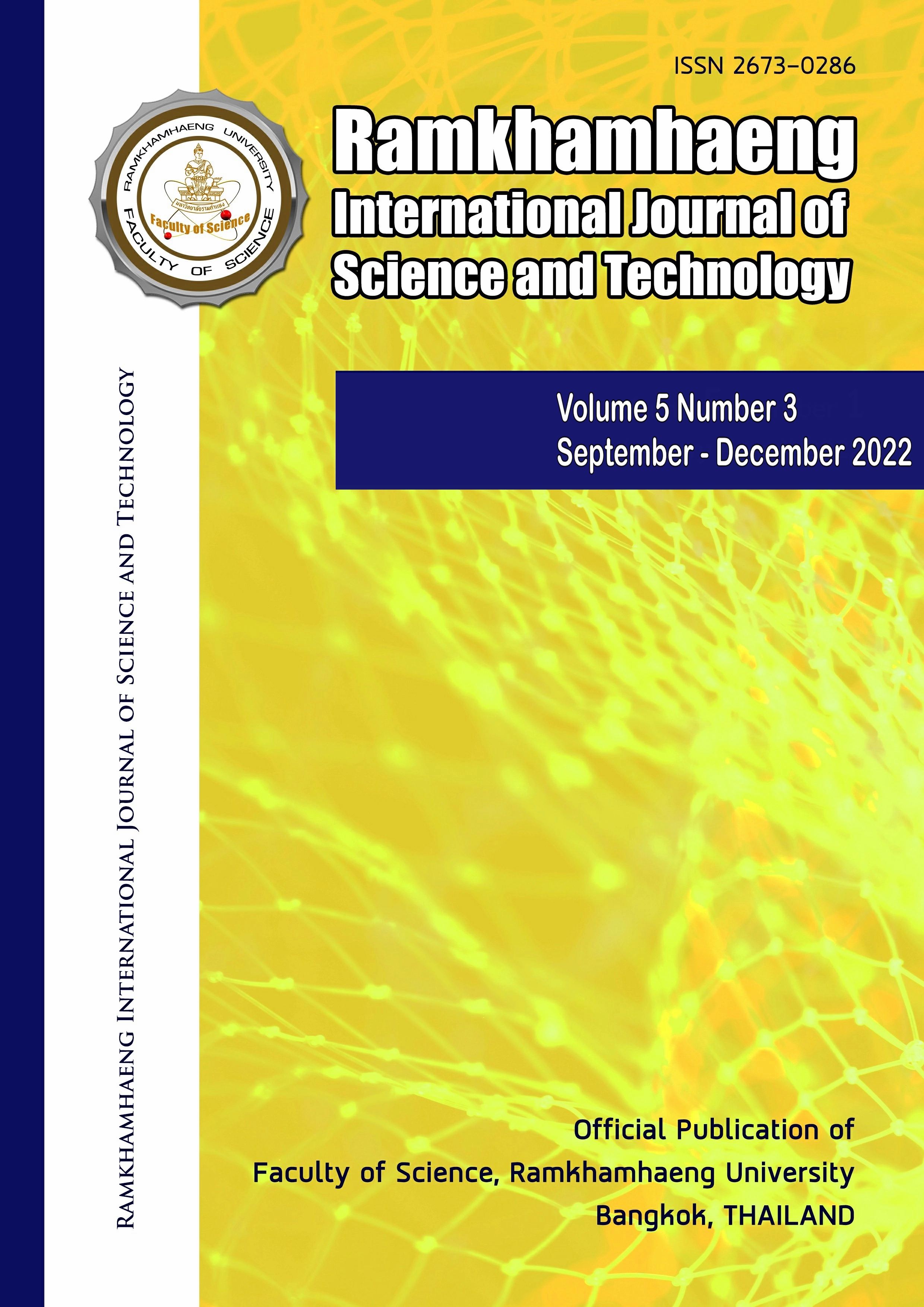Antibacterial and Cytotoxic Activities of Rhodomyrtone Derivatives
Keywords:
Rhodomyrtone, Rhodomyrtone derivatives, Rhodomyrtus tomentosa, Anticancer, Antibacterial, AcylphloroglucinolsAbstract
Rhodomyrtone, a bioactive acylphloroglucinols compound, was obtained from the leaves of Rhodomyrtus tomentosa (Aiton.) Hassk and had been scientifically evidenced as multiple potential pharmacological activities. The purpose of research is to synthesize rhodomyrtone derivatives and evaluated for their antibacterial and anticancer activities. Rhodomyrtone derivatives 2-12 were synthesized and their structures were elucidated by spectroscopic techniques. The results indicated that rhodomyrtone showed antibacterial activity similar to that of a standard drug (vancomycin). It exhibited higher activity than derivatives. Rhodomyrtone (1) exhibited highest anticancer activity against H460 and PC3 cells with IC50 value of 6.12 and 13.30 mM. Whereas, derivatives 8 and 9 gave higher anticancer activity against HeLa cell than rhodomyrtone.
References
Bach Q, Hongthong NS, Quach LT, Pham LV, Pham TV, Kuhakarn C, Reutrakul V, Nguyen PTM (2020) Antimicrobial activity of rhodomyrtone isolated from Rhodomyrtus tomentosa (Aiton) Hassk. Nat. Prod. Res. 34:2518-2523.
Chorachoo J, Saeloh D, Srichana T, Amnuaikit T, Musthafa KS, Sretrirutchai S, Voravuthikunchai SP (2016) Rhodomyrtone as a potential anti-proliferative and apoptosis inducing agent in HaCaT keratinocyte cells. Eur. J. Pharmacol. 772:144–151.
Hamid HA, Zeyohannes SS, Yusoff MM (2017) Rhodomyrtus tomentosa: a phytochemical and pharmacological review. Asian J. Pharm. Clin. Res. 10:10–16.
Leejae S, Yingyongnarongkul B, Suksamrarn A, Voravuthikunchai SP (2012) Synthesis and structure–activity relationship of rhodomyrtone derivatives as antibacterial agent. Chin. Chem. Lett. 23:1011–1014.
Limsuwan S, Hesseling-Meinders A, Voravuthikunchai SP, van Dijl JM, Kayser O (2011) Potential antibiotic and anti-infective effects of rhodomyrtone from Rhodomyrtus tomentosa (Aiton) Hassk on Streptococcus pyogens as revealed by proteomics. Phytomed.18:934–940.
Limsuwan S, Trip EN, Kouwen TR, Piersma S, Hiranrat A, Mahabusarakam W, Voravuthikunchai SP, Van DJM, Kayser O (2009) Rhodomyrtone: a new candidate as natural antibacterial drug from Rhodomyrtus tomentosa. Phytomed. 16: 645–651.
Limsuwan S, Voravuthikunchai SP (2008) Boesenbergia pandurata (Roxb.) Schltr., Eleutherine americana Merr. and Rhodomyrtus tomentosa (Aiton) Hassk. as antibiofilm producing and antiquorum sensing in Streptococcus pyogenes. FEMS. Immunol. Med. Microbiol. 53:429–436.
Sianglum W, Srimanote P, Wonglumsom W, Kittiniyom K, Voravuthikunchai SP (2011) Proteome analyses of cellular proteins in methicillin-resistant Staphylococcus aureus treated with rhodomyrtone, a novel antibiotic candidate. PLoS One 6:16628.
Tayeh M, Nilwarangoon S, Mahabusarakum W, Watanapokasin R (2017) Antimetastatic effect of rhodomyrtone from Rhodomyrtus tomentosa on human skin cancer cells. Int. J. Oncol. 50:1035–1043.
Thongbamrer C, Roobsoong W, Sattabongkot J, Opanasopit P, Yingyongnarongkul B (2021) Serum Compatible Spermine-Based Cationic Lipids with Nonidentical Hydrocarbon Tails Mediate High Transfection Efficiency. ChemBioChem 23:e202100672.
Wunnoo S, Saising J, Voravuthikunchai SP (2017) Rhodomyrtone inhibits lipase production, biofilm formation, and disorganizes established biofilm in Propionibacterium acnes. Anaerobe 43:61–68.
Zhang Y, Li BW, Jiang L, Yang L, Chen NH, Wu ZN, Wang GC (2018) Cytotoxic and anti-inflammatory active phloroglucinol derivatives from Rhodomyrtus tomentosa. Phytochemistry 153: 111–119.
Zhao Z, Wu L, Xie J, Feng Y, Tian J, He X, Li B, Wang L, Wang X, Zhang Y, Wu S, Zheng X (2019) Rhodomyrtus tomentosa (Aiton.): A review of phytochemistry, pharmacology and industrial applications research progress. Food Chem. 309:125715.
Downloads
Published
Issue
Section
License
Copyright (c) 2022 Ramkhamhaeng International Journal of Science and Technology

This work is licensed under a Creative Commons Attribution-NonCommercial-NoDerivatives 4.0 International License.
Copyright Notice: a copyright on any article in the published journal is retained by the Ramkhamhaeng International Journal of Science and Technology. Readers or Users grant the right to use of the Article contained in the Content in accordance with the Creative Commons CC BY-NC-ND license and the Data contained in the Content in accordance with the Creative Commons CC BY-NC-ND.



